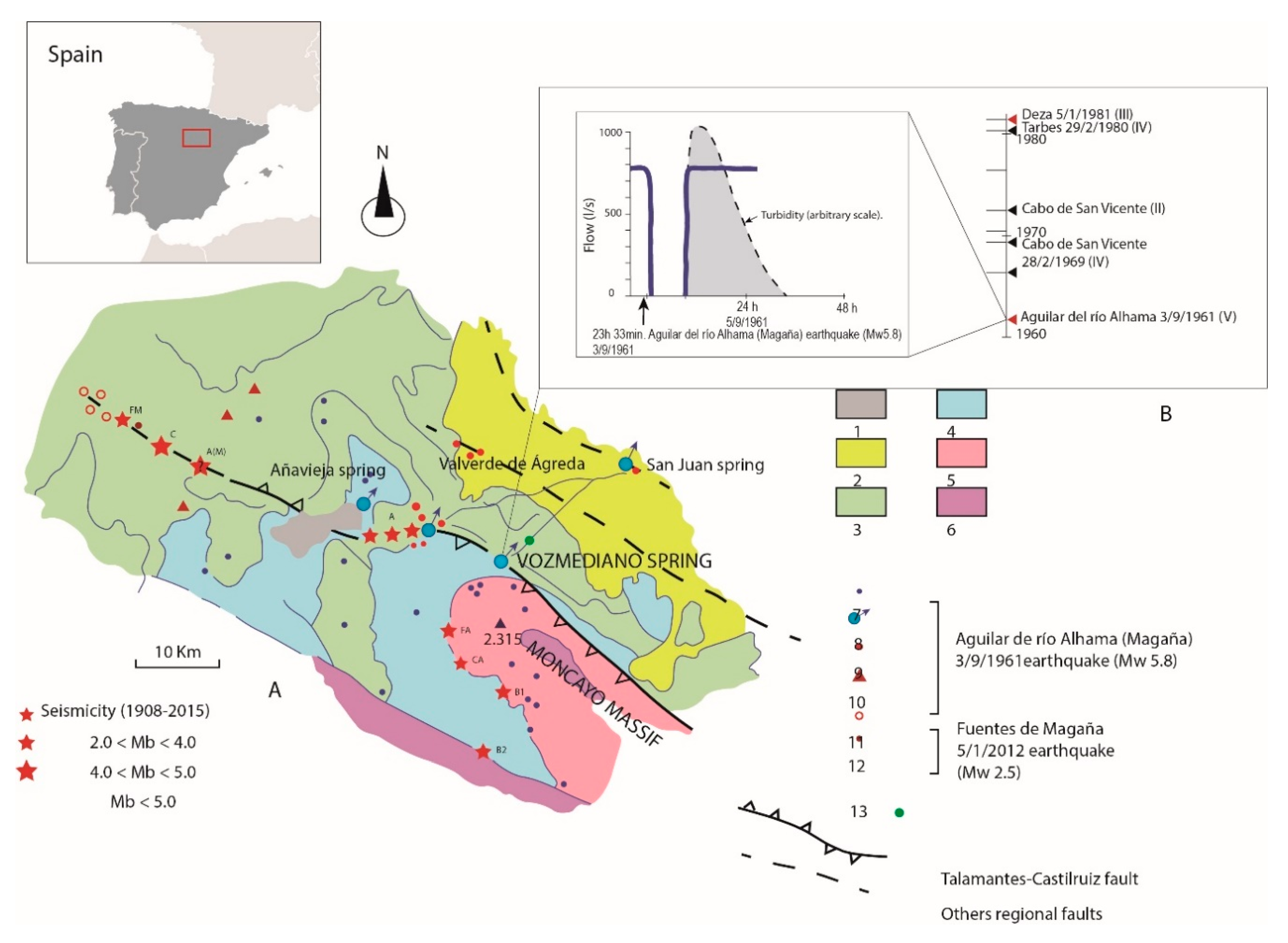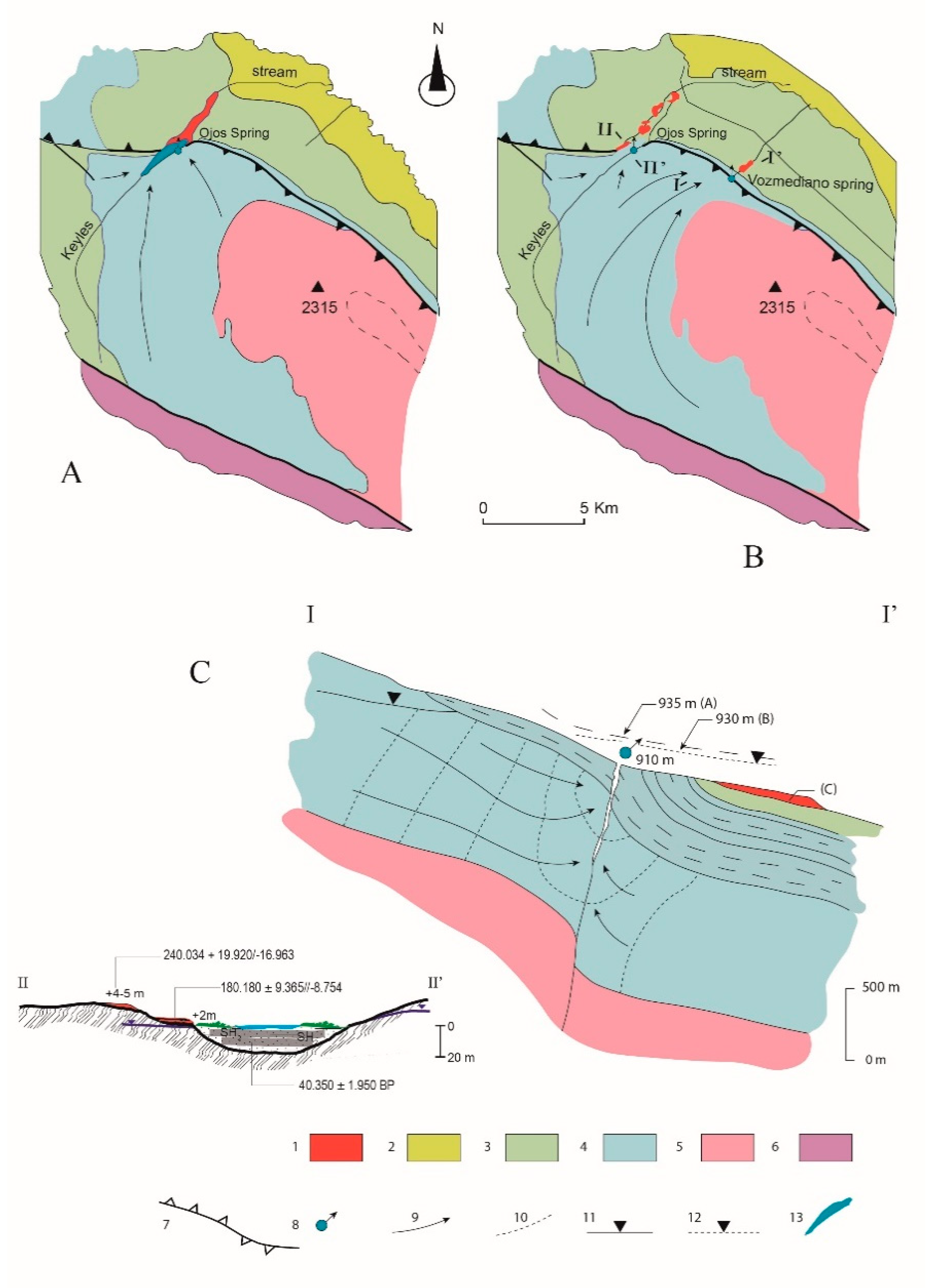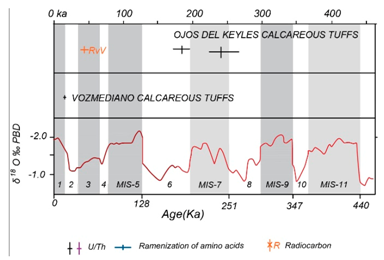Hydrogeological Changes along a Fault Zone Caused by Earthquakes in the Moncayo Massif (Iberian Chain, Spain)
Abstract
1. Introduction and Objectives
2. Study Area
3. Methodology
- The hydrogeological field investigations consisted of collecting information regarding hydrological alterations in 27 villages around the Talamantes–Castilruiz fault through interviews with people from the area, water supply entities, employees of power plants, etc. All of the springs that suffered some alterations were visited and inventoried.
- Analysis of the alterations observed in the hydrograph of the Vozmediano spring over a period of 20 years to identify responses to earthquakes.
- To determine ancient changes in the flow of groundwater due to earthquakes, a study was made on the calcareous tuffs of the springs. This cartographic study made it possible to locate the tufa outcrops associated with the Vozmediano and Ojos del Queiles springs. There is a distance of six kilometers between the two springs; in this space there are no other tuff deposits that indicate the existence of a paleo-spring. Five tuff samples from these springs were collected for dating via a U/Th imbalance series carried out at the Institute of Earth Sciences “Jaime Almera” of the CSIC using ICP-MS [19]. Preparation of the samples and radiometric dating using 14C was carried out by the Instituto Rocasolano of the CSIC (Consejo Superior de Investigaciones Científicas).
4. Results
4.1. Observations and Hydraulic Responses: Spring Flow Changes Along the Talamantes–Castilruiz Fault Zone Caused by Multiple Earthquakes
Other Variations in the Flow of the Vozmediano Spring Related to Earthquakes
4.2. The Calcareous Tuffs Associated with the Springs
5. Discussion
5.1. Discussion on Possible Mechanisms
5.2. Modification of the Underground Flow due to the Effects of an Earthquake: The New Vozmediano Spring
6. Conclusions
Author Contributions
Funding
Acknowledgments
Conflicts of Interest
References
- Elkhoury, J.E.; Brodsky, E.E.; Agnew, D.C. Seismic waves increase permeability. Nature 2006, 411, 1135–1138. [Google Scholar] [CrossRef]
- Itaba, S.; Koizumi, N. Earthquake-related changes in groundwater levels at the Dogo hot spring, Japan. Pure Appl. Geophys. 2007, 164, 2397–2410. [Google Scholar] [CrossRef]
- Manga, M. Origin of postseismic streamflow changes inferred from baseflow recession and magnitude-distance relation. Geophys. Res. Lett. 2001, 28, 2133–2136. [Google Scholar] [CrossRef]
- Roeloffs, E.A. Persistent water level changes in a well near Parkfield, California, due to local and distant earthquakes. J. Geophys. Res. 1998, 103, 869–889. [Google Scholar] [CrossRef]
- Sato, T.; Sakai, R.; Furuya, K.; Kodama, T. Coseismic spring flow changes associated with the 1995 Kobe earthquake. Geophys. Res. Lett. 2000, 27, 1219–1222. [Google Scholar] [CrossRef]
- Wang, C.Y.; Chia, Y. Mechanism of water level changes during earthquakes: Near field versus intermediate field. Geophys. Res. Lett. 2008, 35, L12402. [Google Scholar] [CrossRef]
- Wang, C.Y.; Manga, M. Earthquakes and Water; Springer: Berlin/Heidelberg, Germany, 2010. [Google Scholar] [CrossRef]
- Shi, Z.; Wang, G. Aquifers switched from confined to semiconfined by earthquakes. Geophys. Res. Lett. 2016, 43, 11–166. [Google Scholar] [CrossRef]
- Manga, M.; Rowland, J.C. Response of alum rock springs to the October 30, 2007 earthquake and implication for increased discharge after earthquakes. Geofluids 2009, 9, 237–250. [Google Scholar] [CrossRef]
- Muir-Wood, R.; King, G.C.P. Hydrological signatures of earthquake strain. J. Geophys. Res. 1993, 98, 22035–22068. [Google Scholar] [CrossRef]
- Sanz de Ojeda, A.; Alhama, I.; Sanz, E. Aquifer Sensitivity to Earthquakes: The 1755 Lisbon Earthquake. J. Geophys. Res. Solid Earth 2019, 124, 8844–8866. [Google Scholar] [CrossRef]
- Charmoille, A.; Fabbri, O.; Mudry, J.; Guglielmi, Y.; Bertrand, C. Post-seismic permeability change in a shallow fractured aquifer following a M-L 5.1 earthquake (Fourbanne karst aquifer, Jura outermost thrust unit, eastern France). Geophys. Res. Lett. 2005, 32, L18406. [Google Scholar] [CrossRef]
- Manga, M.; Brodsky, E.E.; Boone, M. Response of streamflow to multiple earthquakes and implications for the origin of postseismic discharge changes. Geophys. Res. Lett. 2003, 30, 1214. [Google Scholar] [CrossRef]
- Sanz-Pérez, E.; Menéndez-Pidal, I.; Galindo, R.; López-Querol, S.; Pascual, C. Historical earthquake parameters by geological and seismic site analysis: The 1908 Cerbón earthquake (Spain). Bull. Eng. Geol. Environ. 2016, 75, 1251–1271. [Google Scholar] [CrossRef][Green Version]
- Sanz-Pérez, E. El Karst del sur y Oeste del Moncayo. Ph.D. Thesis, Universidad Complutense de Madrid, Madrid, Spain, 1981. Unpublished. [Google Scholar]
- Sanz-Pérez, E. Le Karst du Sud et de l´Ouest du Moncayo (Cordillera Ibérica). Soria, Espagne. Karstologia 1986, 7, 31–36. [Google Scholar] [CrossRef]
- SGOP. Estudio Hidrogeologico de la Provincia de Soria; Internal Repport; Servicio Geológico de Obras Públicas: Madrid, Spain, 1980. [Google Scholar]
- Sanz-Pérez, E. Application and simplification of the SIMERO model for the Vozmediano Spring (Spain). Hydrol. Sci. J. 1996, 41, 763–779. [Google Scholar] [CrossRef][Green Version]
- Hellstrom, J. Rapid and accurate U/Th dating using parallel ion-counting multi-collector ICP-MS. J. Anal. At. Spectrom. 2003, 18, 1346–1351. [Google Scholar] [CrossRef]
- Pellicer, F.; Echevarria, M.T. El sistema de terrazas y glacis en el piedemonte septentrional del macizo del Moncayo. In Geografía Física de Aragón. Aspectos Generales y Temáticos; Peña, J.L., Longares, L.A., Sánchez, M., Eds.; Universidad de Zaragoza e Institución Fernando el Católico: Zaragoza, Spain, 2004; pp. 163–171. [Google Scholar]
- Sanz-Pérez, E.; Pascual, C.; de Ojeda, L.S.; Menéndez-Pidal, I. La antigua laguna de Agreda. Celtiberia 2015, 109, 177–191. [Google Scholar]
- Léonardi, V.; Arthaud, F.; Tovmassian, A.; Karakhanian, A. Tectonic and seismic conditions for changes in spring discharge along the Garni right lateral strike slip fault (Armenian Upland). Geodin. Acta 1998, 11, 85–103. [Google Scholar] [CrossRef]
- García-Gil, A.; Sánchez-Navarro, J.A.; Pérez-García, A.; Vázquez-Suñe, E.; Matéo, J. Cuantificación del flujo subterráneo en la vertiente suroccidental del Macizo del Moncayo, España. Geogaceta 2013, 54, 107–110. [Google Scholar]
- Gil Imaz, A. La Estructura de la Sierra de Cameros: Deformación Dúctil y su Significado a Escala Cortical; Centro de Estudios Riojanos: Logroño, España, 2001; 305p, ISBN 84-95747-09-X.



| Location | Sample | AGE (Years before Present) | Dating Method | |
|---|---|---|---|---|
| Vozmediano spring | Calcareous tuff terrace | 19,159 | +957/−950 | 230Th/234U |
| Ojos del Queiles springs | Calcareous tuff dam | 240,034 | +19,920/−16,963 | 230Th/234U |
| Calcareous tuff terrace | 180,108 | +9,365/−8754 | ||
| Lake organic deposits | 40,350 | ±1950 | 14C | |
Publisher’s Note: MDPI stays neutral with regard to jurisdictional claims in published maps and institutional affiliations. |
© 2020 by the authors. Licensee MDPI, Basel, Switzerland. This article is an open access article distributed under the terms and conditions of the Creative Commons Attribution (CC BY) license (http://creativecommons.org/licenses/by/4.0/).
Share and Cite
Sanz, E.; Menéndez Pidal, I.; Escavy, J.I.; Ojeda, J.S.d. Hydrogeological Changes along a Fault Zone Caused by Earthquakes in the Moncayo Massif (Iberian Chain, Spain). Sustainability 2020, 12, 9034. https://doi.org/10.3390/su12219034
Sanz E, Menéndez Pidal I, Escavy JI, Ojeda JSd. Hydrogeological Changes along a Fault Zone Caused by Earthquakes in the Moncayo Massif (Iberian Chain, Spain). Sustainability. 2020; 12(21):9034. https://doi.org/10.3390/su12219034
Chicago/Turabian StyleSanz, Eugenio, Ignacio Menéndez Pidal, José Ignacio Escavy, and Joaquin Sanz de Ojeda. 2020. "Hydrogeological Changes along a Fault Zone Caused by Earthquakes in the Moncayo Massif (Iberian Chain, Spain)" Sustainability 12, no. 21: 9034. https://doi.org/10.3390/su12219034
APA StyleSanz, E., Menéndez Pidal, I., Escavy, J. I., & Ojeda, J. S. d. (2020). Hydrogeological Changes along a Fault Zone Caused by Earthquakes in the Moncayo Massif (Iberian Chain, Spain). Sustainability, 12(21), 9034. https://doi.org/10.3390/su12219034





